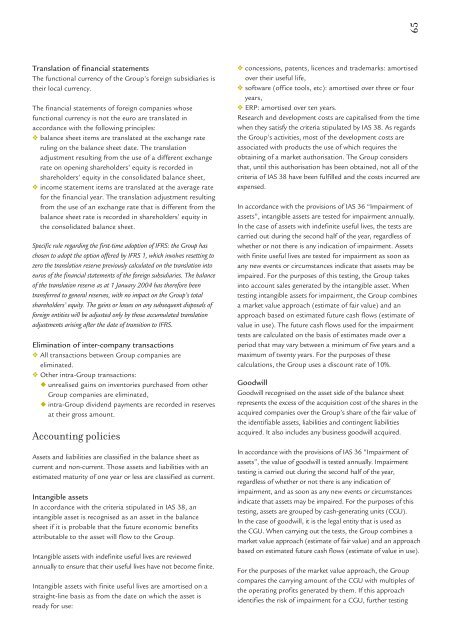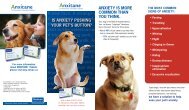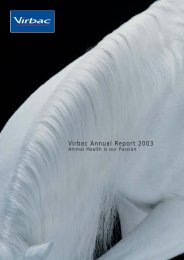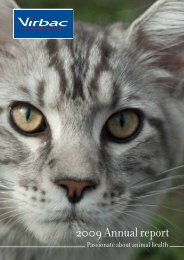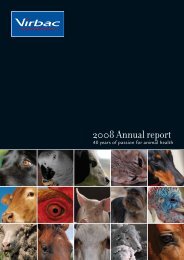2005 Annual report - Virbac
2005 Annual report - Virbac
2005 Annual report - Virbac
Create successful ePaper yourself
Turn your PDF publications into a flip-book with our unique Google optimized e-Paper software.
65<br />
Translation of financial statements<br />
The functional currency of the Group’s foreign subsidiaries is<br />
their local currency.<br />
The financial statements of foreign companies whose<br />
functional currency is not the euro are translated in<br />
accordance with the following principles:<br />
❖ balance sheet items are translated at the exchange rate<br />
ruling on the balance sheet date. The translation<br />
adjustment resulting from the use of a different exchange<br />
rate on opening shareholders’ equity is recorded in<br />
shareholders’ equity in the consolidated balance sheet,<br />
❖ income statement items are translated at the average rate<br />
for the financial year. The translation adjustment resulting<br />
from the use of an exchange rate that is different from the<br />
balance sheet rate is recorded in shareholders’ equity in<br />
the consolidated balance sheet.<br />
Specific rule regarding the first-time adoption of IFRS: the Group has<br />
chosen to adopt the option offered by IFRS 1, which involves resetting to<br />
zero the translation reserve previously calculated on the translation into<br />
euros of the financial statements of the foreign subsidiaries. The balance<br />
of the translation reserve as at 1 January 2004 has therefore been<br />
transferred to general reserves, with no impact on the Group’s total<br />
shareholders’ equity. The gains or losses on any subsequent disposals of<br />
foreign entities will be adjusted only by those accumulated translation<br />
adjustments arising after the date of transition to IFRS.<br />
Elimination of inter-company transactions<br />
❖ All transactions between Group companies are<br />
eliminated.<br />
❖ Other intra-Group transactions:<br />
◆ unrealised gains on inventories purchased from other<br />
Group companies are eliminated,<br />
◆ intra-Group dividend payments are recorded in reserves<br />
at their gross amount.<br />
Accounting policies<br />
Assets and liabilities are classified in the balance sheet as<br />
current and non-current. Those assets and liabilities with an<br />
estimated maturity of one year or less are classified as current.<br />
Intangible assets<br />
In accordance with the criteria stipulated in IAS 38, an<br />
intangible asset is recognised as an asset in the balance<br />
sheet if it is probable that the future economic benefits<br />
attributable to the asset will flow to the Group.<br />
Intangible assets with indefinite useful lives are reviewed<br />
annually to ensure that their useful lives have not become finite.<br />
Intangible assets with finite useful lives are amortised on a<br />
straight-line basis as from the date on which the asset is<br />
ready for use:<br />
❖ concessions, patents, licences and trademarks: amortised<br />
over their useful life,<br />
❖ software (office tools, etc): amortised over three or four<br />
years,<br />
❖ ERP: amortised over ten years.<br />
Research and development costs are capitalised from the time<br />
when they satisfy the criteria stipulated by IAS 38. As regards<br />
the Group’s activities, most of the development costs are<br />
associated with products the use of which requires the<br />
obtaining of a market authorisation. The Group considers<br />
that, until this authorisation has been obtained, not all of the<br />
criteria of IAS 38 have been fulfilled and the costs incurred are<br />
expensed.<br />
In accordance with the provisions of IAS 36 “Impairment of<br />
assets”, intangible assets are tested for impairment annually.<br />
In the case of assets with indefinite useful lives, the tests are<br />
carried out during the second half of the year, regardless of<br />
whether or not there is any indication of impairment. Assets<br />
with finite useful lives are tested for impairment as soon as<br />
any new events or circumstances indicate that assets may be<br />
impaired. For the purposes of this testing, the Group takes<br />
into account sales generated by the intangible asset. When<br />
testing intangible assets for impairment, the Group combines<br />
a market value approach (estimate of fair value) and an<br />
approach based on estimated future cash flows (estimate of<br />
value in use). The future cash flows used for the impairment<br />
tests are calculated on the basis of estimates made over a<br />
period that may vary between a minimum of five years and a<br />
maximum of twenty years. For the purposes of these<br />
calculations, the Group uses a discount rate of 10%.<br />
Goodwill<br />
Goodwill recognised on the asset side of the balance sheet<br />
represents the excess of the acquisition cost of the shares in the<br />
acquired companies over the Group’s share of the fair value of<br />
the identifiable assets, liabilities and contingent liabilities<br />
acquired. It also includes any business goodwill acquired.<br />
In accordance with the provisions of IAS 36 “Impairment of<br />
assets”, the value of goodwill is tested annually. Impairment<br />
testing is carried out during the second half of the year,<br />
regardless of whether or not there is any indication of<br />
impairment, and as soon as any new events or circumstances<br />
indicate that assets may be impaired. For the purposes of this<br />
testing, assets are grouped by cash-generating units (CGU).<br />
In the case of goodwill, it is the legal entity that is used as<br />
the CGU. When carrying out the tests, the Group combines a<br />
market value approach (estimate of fair value) and an approach<br />
based on estimated future cash flows (estimate of value in use).<br />
For the purposes of the market value approach, the Group<br />
compares the carrying amount of the CGU with multiples of<br />
the operating profits generated by them. If this approach<br />
identifies the risk of impairment for a CGU, further testing


